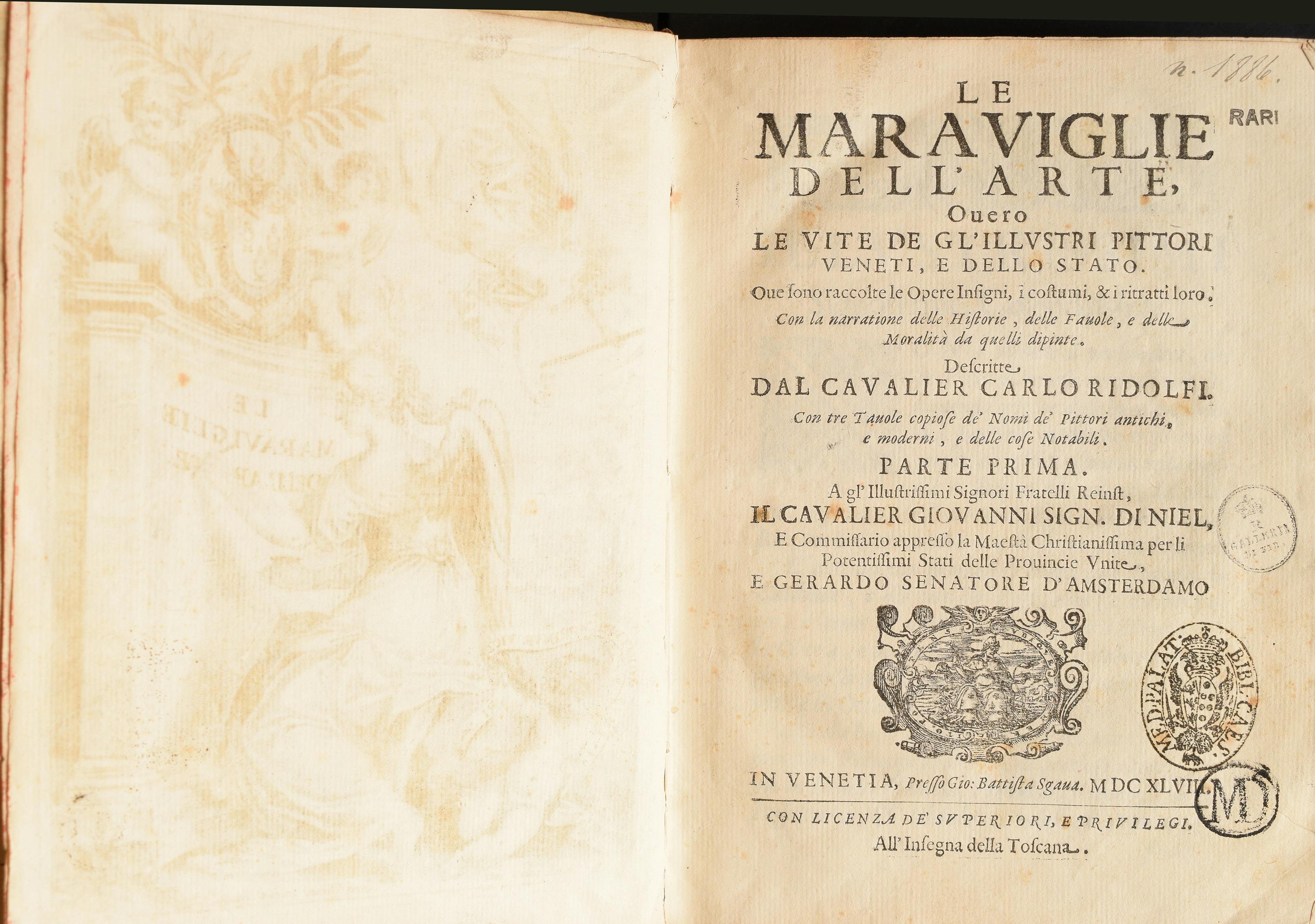Le maraviglie dell'arte, overo le vite de gl'illustri pittori veneti, e dello stato (The marvels of art or the lives of the famous painters of Venice and its State)
Carlo Ridolfi, Lonigo (Vicenza), 1594 - Venice, 1658
Full title: Le maraviglie dell'arte, overo le vite de gl'illustri pittori veneti, e dello stato. Ove sono raccolte le opere insigni , i costumi, & i ritratti loro. Con la narratione delle historie, delle favole, e delle moralità da quelli dipinte. Descritte dal cavalier Carlo Ridolfi. Con tre tavole copiose de’ nomi de’ pittori antichi, e moderni, e delle cose notabili, in Venetia, presso Gio.Battista Sgava, all’insegna della Toscana, 1648, parte prima[-seconda]. Altro titolo: Delle maraviglie dell’arte, overo delle vite de gl’illustri pittori veneti, e dello Stato.
According to his autobiography, which he wrote in the appendix to his Maraviglie dell'arte, Carlo Ridolfi was born in Lonigo, in the province of Vicenza, from a family of humble origins. He started painting at an early age under the guidance of a German artist, and was then sent to a workshop in Venice held by the painter Antonio Vassilacchi, known as l'Aliense. After a five-year apprenticeship, he managed to work as a self-employed painter in Lonigo, Verona, Treviso and Venice. After the plague of 1630, having lost many of his early patrons, Ridolfi began attending the Venetian Accademia degli Incogniti. Unfortunately, his humble condition did not allow him to be admitted to the academic ranks. However, his academic friends gave him various assignments as a portrait artist and engraver of book frontispieces. Moreover, since he also happened to try his hand at literary and poetic compositions, they suggested that he should dedicate himself to the literary genre of illustrious biographies. Therefore, Carlo Ridolfi started to conceive his project of writing a collection of biographies of Venetian artists in response to Vasari's Lives, probably encouraged also by typographer Bernardo Giunti, who was heir to the typographers of the second edition of Vasari's Lives and who, at the time, was living in Venice.
Maraviglie dell'Arte, published in 1648, was immediately highly appreciated for the large amount of information on Venetian artists, which was often reported first-hand by Ridolfi.
The work was also valuable for its information on the environment of local art collectors and dealers, who Ridolfi proved to know very well, perhaps due to his occasional activities as a “matchmaker” and intermediary at the art market in Venice. While criticising the Tuscan-centric vision of art proposed by Giorgio Vasari in his Lives and claiming equal dignity for Venetian artists compared to Tuscan ones, in his Maraviglie dell'arte Ridolfi was clearly inspired by the second edition of Vasari's Lives: not only the general structure of the work was very similar, but also the attention for the artistic aspect of the publication, as some of the engraved portraits of Venetian artists, which precede the narration of their lives, were executed from drawings by Ridolfi.
A.Polati, ad vocem “Ridolfi, Carlo”, in, Dizionario Biografico degli Italiani, vol. 87, Roma, 2016, pp. 440-443;A. Polati, Il cavalier Carlo Ridolfi (1594-1658). La vita e l’opera pittorica, Vicenza, 2010;C.Basagni, Le fonti per la conoscenza delle donne pittrici e musiciste, in Con dolce forza: donne nell’universo musicale del Cinque e Seicento, catalogo della mostra (Ponte a Ema, Bagno a Ripoli (Firenze), Oratorio di Santa Caterina delle Ruote, 8 marzo-13 maggio 2018), a cura di L. Donati, Firenze, 2018, p. 89-94.
